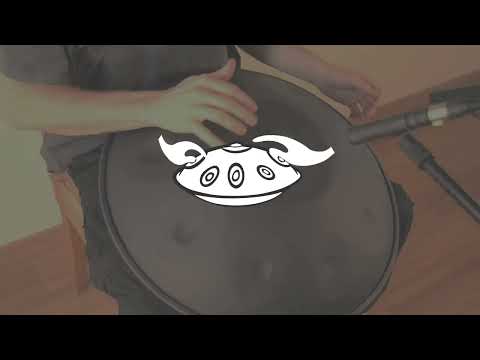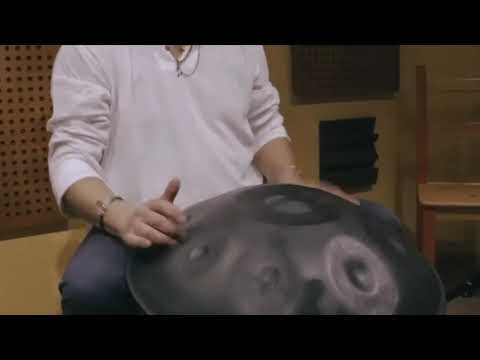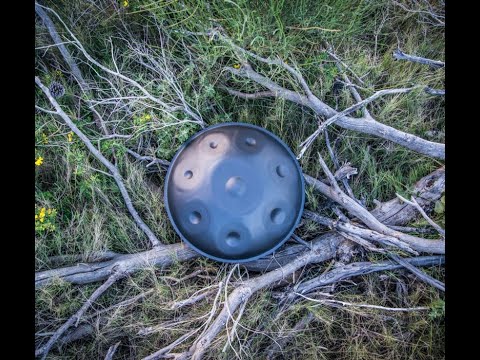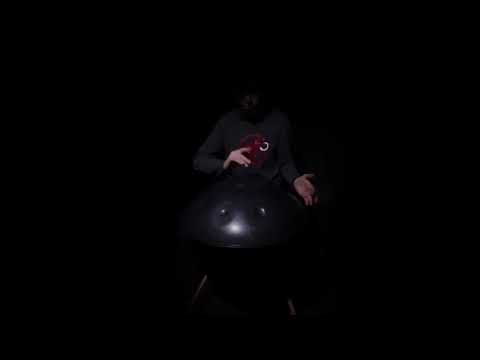Black Magic D Kurd
Black Magic D Kurd











Scorte ridotte: ne restano 1
Lieferbar innerhalb von 7 - 14 Werktagen.
Aktuell nicht vorrätig – Jetzt als Sonderanfertigung vorbestellen Unsere Handpans werden mit größter Sorgfalt und Präzision handgefertigt, um Dir höchste Klangqualität zu garantieren. Diese außergewöhnliche Qualität benötigt jedoch Zeit.Hier findest Du eine Übersicht der voraussichtlichen Fertigungsdauer:
• Standard-Instrumente (9-12 Noten, Grundtöne G3 bis B2): ca. 4 bis 10 Wochen
• Sonderanfertigungen mit tiefen Stimmungen (Grundton A2-E2): bis zu 3 Monate
• Bottomnote-Instrumente bis 15 Noten: bis zu 3,5 Monate
• Bottomnote-Instrumente bis 21 Noten: bis zu 4 Monate
• Bei den Herstellern Svaraa, Aya Sounds, NamiPan und Handromeda ist aufgrund hoher Nachfrage mit längeren Fertigungszeiten zu rechnen. Currently out of stock - pre-order now as a custom-made product Our handpans are handmade with the utmost care and precision to guarantee you the highest sound quality. However, this exceptional quality takes time.
Here you can find an overview of the expected production times:
•Standard instruments (9-12 notes, fundamental notes G3 to B2): approx. 4 to 10 weeks
•Custom-made items with low tunings (fundamental notes A2-E2): up to 3 months
•Bottom note instruments up to 15 notes: up to 3.5 months
•Bottom note instruments up to 21 notes: up to 4 months
•Due to high demand, longer production times can be expected for the manufacturers Svaraa, Aya Sounds, NamiPan and Handromeda.
Special features of the Black Magic Handpan are a balanced tone, also known as timbre, as well as very high tuning stability and rust resistance. It has a powerful sound and is therefore ideal for both beginners and advanced users.
Diameter: 56cm
Height: 25cm
Weight: 3.5kg
Material: nitrided steel (coated DC04 steel)
Mood designation : Kurd
Synonyms : Aeolian / with root C# = Annaziska
Basic tone sequence (8+1): D/ A Bb CDEFGA
Effect : Warm - Mysterious - Dreamy
Tone Stock: Heptatonic
Mode :
Phrygian (tonal center 1st note) = major, or
aeolian (tonal center: Bb) = minor
Semitones : 7 - 1 - 2 - 2 - 2 - 3 - 2 - 2
Tonal center : DING or first tone
mood description:
The Kurd tuning is, if you will, the natural minor variant of the handpan tuning. Due to its particularly harmonious combination of notes, it is particularly suitable for beginners. With them you can play everything from calm and meditative to melancholic to powerful and cheerful.
Even if this mood can sound very sentimental, you can create happy sound patterns with it. For example, there is a major triad on the second and third notes. Just be aware that the second and third notes played at the same time will be rubbing, you can of course also use this tension consciously to spice up your playing so that the relaxation can have a stronger effect afterwards.
This tuning is one of the first seven-note tunings that were built and has become very popular through some videos on the internet.
Tone sequence with 8 tone fields: D/ A Bb CDEFG
Tone sequence with 9 tone fields: D/ A Bb CDEFGA
Origin and music theory of the Kurd tuning:
Kurd adopts the name of the Arabic/Turkish maqam Kurd. This selection of tones also shares the arrangement of the tones with this maqam, assuming that the tonal center is on the first tone in the circle. This is how the full Phrygian mode is created, which is characterized by a semitone step from the root to the second tone of the scale and is responsible for the mysterious sound of the scale.
However, an ambivalence remains, as the DING is a fifth below the first tone and thus appears as a second tonal center, which allows the mode to change to Aeolian (natural minor). Depending on how you play, you can switch between natural minor and Phrygian sound character. With Kurd , everything can be played in a variety of ways, from calm and meditative to melancholic to powerful and happy.
Kurd shares with other minor variations (cf. Celtic Minor/ Integral) the jump from a fifth from DING to the first note. From this fifth degree, assuming that the tonal center is the THING, one has all the steps of a natural minor scale (Aeolian). What is special about Kurd is the semitone step between the first and second tone. This step is also present in the Maqam Kurd (Arabic or Turkish scale system) of the same name (cf. Semai Kurd), but also in the Phrygian mode. The Phrygian mode is used in jazz, psychedelic rock, flamenco and fado, but also in classical music.
Matching Moods:
Very well suited for playing together, improvisatively:
- F Sabye (parallel key)
- F major (parallel key)
- D Celtic Minor / Amara
- G Celtic Minor / Amara
- D Aeolian
- Bb Aegean
- D equinox
- D Magic Voyage
- D integral
- D Pygmy
Also good for composing together:
- A Celtic Minor / Amara
- A Hijaz
- C Kurd
- C Celtic Minor / Amara
- F Ragadesh
Product description
Product description
Special features of the Black Magic Handpan are a balanced tone, also known as timbre, as well as very high tuning stability and rust resistance. It has a powerful sound and is therefore ideal for both beginners and advanced users.
specifications
specifications
Diameter: 56cm
Height: 25cm
Weight: 3.5kg
Material: nitrided steel (coated DC04 steel)
About the mood
About the mood
Mood designation : Kurd
Synonyms : Aeolian / with root C# = Annaziska
Basic tone sequence (8+1): D/ A Bb CDEFGA
Effect : Warm - Mysterious - Dreamy
Tone Stock: Heptatonic
Mode :
Phrygian (tonal center 1st note) = major, or
aeolian (tonal center: Bb) = minor
Semitones : 7 - 1 - 2 - 2 - 2 - 3 - 2 - 2
Tonal center : DING or first tone
mood description:
The Kurd tuning is, if you will, the natural minor variant of the handpan tuning. Due to its particularly harmonious combination of notes, it is particularly suitable for beginners. With them you can play everything from calm and meditative to melancholic to powerful and cheerful.
Even if this mood can sound very sentimental, you can create happy sound patterns with it. For example, there is a major triad on the second and third notes. Just be aware that the second and third notes played at the same time will be rubbing, you can of course also use this tension consciously to spice up your playing so that the relaxation can have a stronger effect afterwards.
This tuning is one of the first seven-note tunings that were built and has become very popular through some videos on the internet.
Tone sequence with 8 tone fields: D/ A Bb CDEFG
Tone sequence with 9 tone fields: D/ A Bb CDEFGA
Origin and music theory of the Kurd tuning:
Kurd adopts the name of the Arabic/Turkish maqam Kurd. This selection of tones also shares the arrangement of the tones with this maqam, assuming that the tonal center is on the first tone in the circle. This is how the full Phrygian mode is created, which is characterized by a semitone step from the root to the second tone of the scale and is responsible for the mysterious sound of the scale.
However, an ambivalence remains, as the DING is a fifth below the first tone and thus appears as a second tonal center, which allows the mode to change to Aeolian (natural minor). Depending on how you play, you can switch between natural minor and Phrygian sound character. With Kurd , everything can be played in a variety of ways, from calm and meditative to melancholic to powerful and happy.
Kurd shares with other minor variations (cf. Celtic Minor/ Integral) the jump from a fifth from DING to the first note. From this fifth degree, assuming that the tonal center is the THING, one has all the steps of a natural minor scale (Aeolian). What is special about Kurd is the semitone step between the first and second tone. This step is also present in the Maqam Kurd (Arabic or Turkish scale system) of the same name (cf. Semai Kurd), but also in the Phrygian mode. The Phrygian mode is used in jazz, psychedelic rock, flamenco and fado, but also in classical music.
Matching Moods:
Very well suited for playing together, improvisatively:
- F Sabye (parallel key)
- F major (parallel key)
- D Celtic Minor / Amara
- G Celtic Minor / Amara
- D Aeolian
- Bb Aegean
- D equinox
- D Magic Voyage
- D integral
- D Pygmy
Also good for composing together:
- A Celtic Minor / Amara
- A Hijaz
- C Kurd
- C Celtic Minor / Amara
- F Ragadesh
Questions & answers when buying a handpan:
Collapsible row
Our handpans are elaborately crafted by hand. Even though our handpans are made with the utmost care and craftsmanship, natural differences in color, slight variations in design and minimal manufacturing marks, such as fine scratches or unevenness on the tone fields and the sound body, may occur.
Visible hammer marks, which are caused by the precise tuning of the instrument by hand, are characteristic features of handmade handpans. They are evidence of authentic craftsmanship and do not represent a quality defect. On the contrary, they emphasize the uniqueness of each instrument.
Collapsible row
Pre-orders:
Are you interested in a handpan that we don't currently have in stock? No problem, we can have your desired handpan made for you.
Custom-made products:
At Handpan.World you can order your handpan exactly as you want it - be it the scale, the note layout or other individual details.
Do you have a special scale or note layout in mind that we don't offer as standard? We can have your handpan made to your specifications by the manufacturer of your choice.
Contact us by email at service@handpan.world or by phone if you have any special requests.
Our handpans are manufactured with the utmost care and precision to guarantee the highest sound quality. However, this quality takes time. Below you will find an overview of the estimated production time for your handpan:
Estimated production time:
- Standard instruments (9-12 notes, root notes G3 to B2): approx. 4 to 10 weeks
- Custom-made instruments with low tunings (fundamental A2-E2): up to 3 months
- Bottomnote instruments up to 15 notes: up to 3.5 months
- Bottom-note instruments up to 21 notes: up to 4 months
- Longer production times are to be expectedfor the manufacturers Svaraa, Aya Sounds, NamiPan and Handromeda, in particular due to the high volume of orders.
Note: The stated production times are estimates and do not represent binding delivery dates. Additional factors such as shipping times or possible customs clearance may extend the delivery time.
The estimates are based on our previous experience and are provided without guarantee. Depending on the order situation, delays in the processes or unforeseeable events, the actual production time may vary and may be shorter or longer.
You are welcome to contact us at any time to inquire about progress and estimated delivery times.
Note: All items not in stock are produced separately at the customer's request and are considered custom-made in accordance with § 312 d para. 4 BGB .
Pre-orders in accordance with Article L 121-20-12 of the Consumer Code are expressly not offered.
Info & tips for buying a handpan
Visualizza tutto-

Buying used handpans: tips and information
Discover the pros and cons of buying used handpans and what to look out for. Get tips on price-performance and technical development for the best purchase.
Buying used handpans: tips and information
Discover the pros and cons of buying used handpans and what to look out for. Get tips on price-performance and technical development for the best purchase.
-

Handpan Drum Buying Guide
Welcome to our comprehensive buying guide for handpans – we want to help you find the right handpan for you by highlighting the crucial criteria: material, sound, quality, service and...
Handpan Drum Buying Guide
Welcome to our comprehensive buying guide for handpans – we want to help you find the right handpan for you by highlighting the crucial criteria: material, sound, quality, service and...
-

Which Her(t)z type are you?
Make your own subjective impression of the two vibration frequencies of 440Hz and 432Hz.
Which Her(t)z type are you?
Make your own subjective impression of the two vibration frequencies of 440Hz and 432Hz.
Handpan basic knowledge
-

Extended Scales Bottom Note and Mutant Handpans...
Extended Scales and Mutant Handpans are an exciting new development in the world of handpans. They offer you an expanded range of musical possibilities and open up new worlds of...
Extended Scales Bottom Note and Mutant Handpans...
Extended Scales and Mutant Handpans are an exciting new development in the world of handpans. They offer you an expanded range of musical possibilities and open up new worlds of...
-

The fascinating history of the handpan: from it...
The handpan, also known as the hang, is a relatively young instrument that has gained immense popularity in recent years. Its enchanting sound and meditative playing style have captivated people...
The fascinating history of the handpan: from it...
The handpan, also known as the hang, is a relatively young instrument that has gained immense popularity in recent years. Its enchanting sound and meditative playing style have captivated people...
-

Matching handpan tunings
We are often asked about the possibilities of matching handpan tunings. When it comes to buying a second handpan or two close people want to buy two suitable instruments together,...
Matching handpan tunings
We are often asked about the possibilities of matching handpan tunings. When it comes to buying a second handpan or two close people want to buy two suitable instruments together,...






